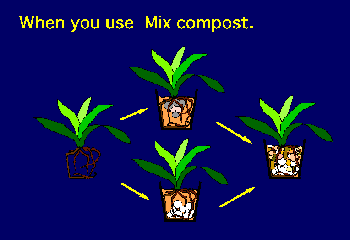
|
| You can grow almost of all orchids in this materials. But some species dont't like and hate this materials. Strictly speaking, you have to change the potting materials dependent on the species. But for the biginners who is not good at watering, this materials is one of the best materials for growing orchids containing Paphs, of course. |
| The mixed potting materials have 3 kinds of basical elements as follows. (a)The hydrophobic materials(b)The hydrophilic materials (c)Ion exchanger For(a), we use various kinds of stones basicaly like volcano stones, especialy Hyuga stone, baked Aka-Tama and Ceraton in Japan. I prefer stone which is rich in Silica. For(b), we use wooden fiber basiacly like bark and tips of coconut. You may use artificial materials like Perite and Venuslite. For(c), we use activated charcoal、zeolite, native ceramics. Each materials are available in selected size in shops. You may choose the size for youe purpose like the bigger and the middle for matured plants, the smaller for seedlings. Commonly, you use the bigger size of materials in the lower part and the smaller in the upper part of pot. Watering is dependent on the size of materials. If you like watering and wet in the pot too much usualy, you had better use the lager size and/or you use the part of stones is larger than the part of wooden fiber. When you use the smaller size or thw wooden part of mix is larger, the mixed materials will not dry so easily. Be careful which materials you use and how much part of the mixture for each factors. |
Mixed Materials |
|
(A) |
(B) |
(C) |
|
| (a) Hydrophobic materials | |||
| Volcano stones or Hyuga stone |
4~5 |
3~4 |
|
| Baked Aka-Tama |
3~4 |
||
| Ceraton |
2 |
||
| (b) Hydrophilic materials | |||
| bark or tips of coconut |
5~4 |
4~3 |
4~3 |
| (c) Ion exchanger | |||
| Activated charcoal or zeolite |
1 |
1 |
|
| Native ceramics |
1 |
| (A) is used in general, (B) is recomended generaly by me, (C) is used materilas by me now. |
| (A)The mixture for general use |
| (B)The mixture I recommend for general using baked Aka-Tama. |
| (C)The mixture I'm using now. I prefer native ceramics, Silica. |
| Note: About native ceramics, I have special writings in other site. Please visit the site if you are interested in. Sorry it is in Japanese only now. In near future, I'll translate in English. |
| After transplantings, you bring the plants in the darker than usual and keep it for a month at least. Be careful for fan and moisture. Don't feed for this period. |
|
|
Continue to(3)Culture |
Back to Index |